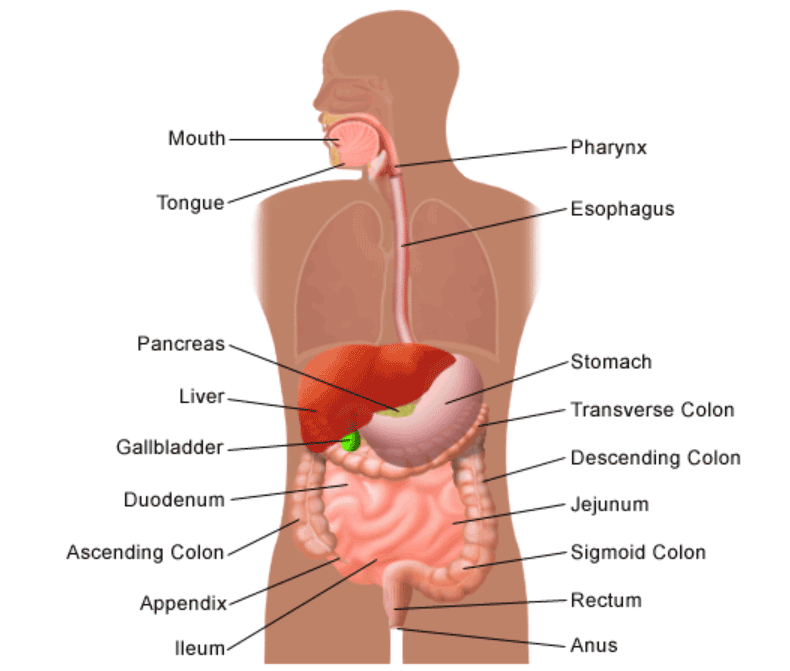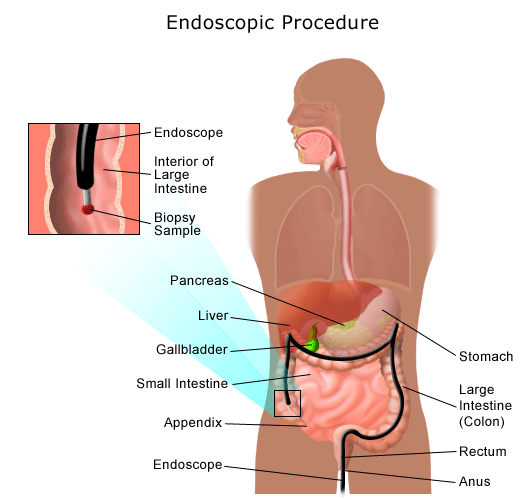Gas in the Digestive Tract
What is gas in the digestive tract?
Gas in the digestive tract is created from:
-
Swallowing air
-
The breakdown of certain foods by the bacteria present in the colon

Everyone has gas. It may be uncomfortable and embarrassing, but it is not life-threatening. Gas is eliminated by burping or passing it through the rectum. Most people produce about 1 to 4 pints of gas a day and pass gas about 14 times a day.
Most gas is made up of odorless vapors--carbon dioxide, oxygen, nitrogen, hydrogen, and sometimes methane. Bacteria in the large intestine release gases that contain sulfur and produce an unpleasant odor of flatulence.
What causes gas in the digestive tract?
Gas in the digestive tract comes from two sources:
-
Aerophagia (air swallowing). This is usually caused by eating or drinking rapidly, chewing gum, smoking, or wearing loose dentures.
Belching is the way most swallowed air leaves the stomach. The remaining gas is partially absorbed into the small intestine and a small amount goes into the large intestine and is released through the rectum.
-
Breakdown of certain undigested foods by harmless bacteria naturally present in the large intestine (colon)
Some carbohydrates (sugar, starches, and fiber) are not digested or absorbed in the small intestine because of a shortage or absence of certain enzymes. The undigested or unabsorbed food then passes into the large intestine, where harmless and normal bacteria break down the food. This process produces hydrogen, carbon dioxide, and, in about one-third of all people, methane gases, which are released through the rectum.
| Foods that commonly cause gas |
|---|
According to the National Institute of Diabetes and Digestive and Kidney Diseases, most foods that contain carbohydrates can cause gas, however, fats and proteins cause little gas. Foods that cause gas include the following:
|
What are the symptoms of gas?
Chronic symptoms caused by too much gas or by a serious disease are rare. The following are the most common symptoms of gas. However, each individual may experience symptoms differently. Symptoms may include:
-
Belching. Belching during or after meals is normal, but people who belch frequently may be swallowing too much air and releasing it before the air enters the stomach.
Chronic belching may also indicate an upper GI disorder, such as peptic ulcer disease, gastroesophageal reflux disease (GERD), or gastritis.
According to the NIDDK, rare, chronic gas syndromes associated with belching include the following:
-
Meganblase syndrome. Meganblase syndrome causes chronic belching. It is characterized by severe air swallowing and an enlarged bubble of gas in the stomach following heavy meals. Fullness and shortness of breath caused by this disorder may mimic a heart attack.
-
Gas-bloat syndrome. Gas-bloat syndrome may occur after surgery to correct GERD. The surgery creates a one-way valve between the esophagus and stomach that allows food and gas to enter the stomach.
-
-
Flatulence. Passing gas through the rectum is called flatulence. Passing gas 14 to 23 times a day is considered normal.
-
Abdominal bloating. Bloating is usually the result of an intestinal motility disorder, such as irritable bowel syndrome (IBS). Motility disorders are characterized by abnormal movements and contractions of intestinal muscles. These disorders may give a false sensation of bloating because of an increased sensitivity to gas.
-
Splenic-flexure syndrome is a chronic disorder that may be caused by gas trapped at bends (flexures) in the colon.
-
Crohn's disease, colon cancer, or any disease that causes intestinal obstruction, may also cause abdominal bloating.
-
Internal hernias or adhesions (scar tissue) from surgery may cause bloating or pain.
-
Fatty foods can delay stomach emptying and cause bloating and discomfort, but not necessarily too much gas.
-
-
Abdominal pain and discomfort. Gas in the intestine causes pain for some people. When it collects on the left side of the colon, the pain can be confused with heart disease. When it collects on the right side of the colon, the pain may feel like the pain associated with gallstones or appendicitis.
The symptoms of gas may resemble other medical conditions or problems. Always consult your doctor for a diagnosis.
How is gas in the digestive tract diagnosed?
Symptoms of gas may be caused by a serious disorder, which should be determined. In addition to a complete medical history and physical examination, your doctor may suggest the following activities to assist in the diagnosis:
-
Food diary. You may be asked to keep a diary of foods and beverages consumed for a specific time period, and/or to count the number of times you pass gas during the day.
-
Colonoscopy. For people 50 years of age and older, and for those with a family history, the possibility of colorectal cancer is considered. Colonoscopy is a procedure that allows the doctor to view the entire length of the large intestine, and can often help identify abnormal growths, inflamed tissue, ulcers, and bleeding. It involves inserting a colonoscope, a long, flexible, lighted tube, in through the rectum up into the colon. The colonoscope allows the doctor to see the lining of the colon, remove tissue for further examination, and possibly treat some problems that are discovered.
-
Sigmoidoscopy. A sigmoidoscopy is a diagnostic procedure that allows the doctor to examine the inside of a portion of the large intestine, and is helpful in identifying the causes of diarrhea, abdominal pain, constipation, abnormal growths, and bleeding. A short, flexible, lighted tube, called a sigmoidoscope, is inserted into the intestine through the rectum. The scope blows air into the intestine to inflate it and make viewing the inside easier.
-
Upper GI (gastrointestinal) series (also called barium swallow). For chronic belching, your doctor will look for signs or causes of excessive air swallowing and may request an upper GI series. An upper GI series is a diagnostic test that examines the organs of the upper part of the digestive system: the esophagus, stomach, and duodenum (the first section of the small intestine). A fluid called barium (a metallic, chemical, chalky, liquid used to coat the inside of organs so that they will show up on an X-ray) is swallowed. X-rays are then taken to evaluate the digestive organs.
Treatment for gas in the digestive tract
Specific treatment for gas in the digestive tract will be determined by your doctor based on:
-
Your age, overall health, and medical history
-
Extent of the condition
-
Your tolerance for specific medications, procedures, or therapies
-
Expectations for the course of the condition
-
Your opinion or preference
Preventing gas in the digestive tract
The most common ways to reduce the discomfort of gas include the following:
-
Changes in the diet
-
Medications
-
Reducing the amount of air swallowed







